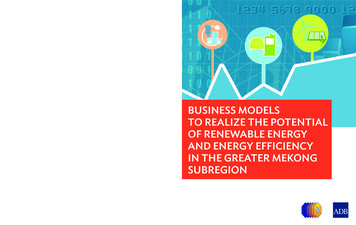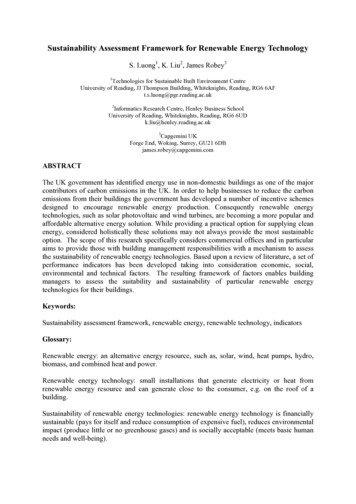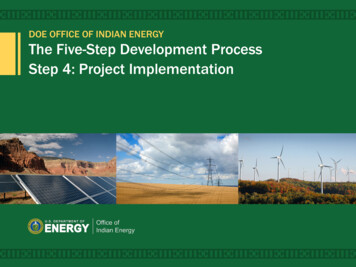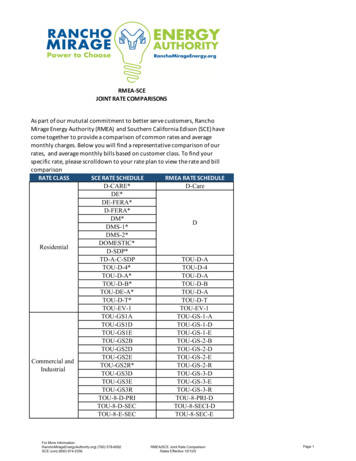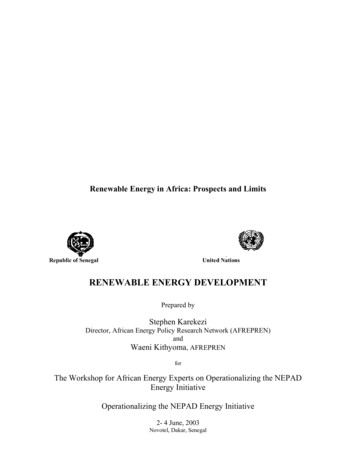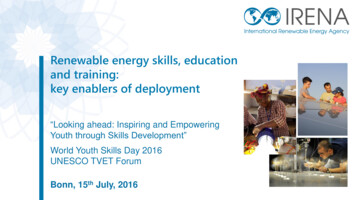
Transcription
Renewable energy skills, educationand training:key enablers of deployment“Looking ahead: Inspiring and EmpoweringYouth through Skills Development”World Youth Skills Day 2016UNESCO TVET ForumBonn, 15th July, 2016
Renewable Energy JobsEmployment in Selected Countries2Source: IRENA (2016), Renewable Energy and Jobs - Annual Review 2016
Renewable Energy JobsEmployment by technologySource: IRENA (2016), Renewable Energy and Jobs - Annual Review 20163
Renewable energy will create more jobsThe renewable energy sector could support up to 24 million jobs in 20308.1 RE (excl. Large hydro) 1.3 Large Hydromillion jobsSource: IRENA (2016), Renewable Energy Benefits: Measuring The Economics.
Renewable energy Occupations
Renewable energy Occupations
Skills demand – solar PV utility scaleLow skilled technical jobs dominate the workforceJob TypesTechnical jobs – low andmedium skill level (e.g.technicians, workers, drivers)Technical jobs – high skill level(e.g. Electrical, civil &mechanical engineers)Non-technical expertise(e.g. regulation, finance,marketing)TotalJobsConstruction workersTechniciansFactory workersTruck drivers and operatorsEngineersExperts in safetyExperts in quality controlLawyer, real estate, risk and regulation expertsExperts in logisticsAdministrationLogistic workersMarketing and commercial professionalsEconomistsEnvironmentalistsJobs (FTE*)/100MW178144413040114107665434903935542% of totalworkforce80%11%9%Around 1,735 GW of solar(PV and CSP) will resultingin 6.4 million jobs in 2030.Most of these jobs will befor low and medium skilledworkforce (80%).490*FTE Full time equivalentSource: IRENA (2016 forthcoming), Opportunities for local value creation from the deployment of wind energy technologies7
Skills demand – wind energyLow skilled technical jobs dominate the workforceJob TypesJobsConstruction workers and technical personnelTechnical jobs – low skillFactory workers (manufacturing)level (e.g. technicians,Professionals managing cranes, trucks, etc.workers, drivers)Logistic expertsEngineersTechnical jobs – high skillsSafety experts(e.g. Electrical, civil &Experts in quality controlmechanical engineers)Geotechnical expertsManagement and AdministrationEnvironmentalistsNon-technical expertise(e.g. regulation, finance,Lawyers, experts in energy regulationmarketing)Marketing and commercial professionalsFinancial analystsTotalJobs (FTE*)/100MW25096409501437247090.412994486523523% of totalworkforce78%13%Around 1,700 GW of windenergy will result in 3.3million jobs in 2030.Most of these jobs will befor low and medium skilledworkforce (78%).8%100%*FTE Full time equivalentSource: IRENA (2016 forthcoming), Opportunities for local value creation from the deployment of wind energy technologies8
Skills demand – large hydro powerShare of jobs in O&M increases as construction slows ion & Maintenance Engineers (electrical,control, mechanical, etc.) Technicians Environmental experts InspectorsShare of jobs in the value chain100%80%60%40%O&M20%ManufacturingConstruction & installation0%201220132014Construction & Installation Engineers (civil, electrical,mechanical etc.) Technicians Environmental experts Construction workers Business developers2015Source: IRENA (2016), Renewable Energy and Jobs - Annual Review 20169
Skill shortages remain a key barrier to growthCurrent skill shortagesAs the solar industry grew rapidly in 2015, it became more difficult tohire qualified employees.In 2013, more than 75% of wind companies found it difficult or verydifficult to find suitably trained staff.Unavailability of appropriately skilled manpower is a prominentchallenge in hiring, especially for positions with low skill requirement.Projected skill gapsThe number of bachelor- and master-level programmes for windenergy needs to be multiplied by 5-10 to reach the 2030 wind targetsIndia’s solar target (100GW of by 2022) requires 1.1 million jobs. Morethan 70% of the these will require medium and low level skills.10
Promoting renewable energy education and trainingA vital part of a conducive policy landscapeEducationandtrainingResearch oymentpoliciesLocal contentrequirementsInvestmentpromotion andtechnologytransferSource: IRENA (2014),The Socio-economic Benefits of Solar and Wind Energy11
Promoting renewable energy education and trainingIRENA’s initiativesRenewable energy and jobs Study of the latest status and trends Analysis of key aspects such as skills, policy making, offgrid and genderIRELP Education centre: Repository of courses, webinarand other educational resources Career centre: Internships and career guidanceCapacity Building Trainings, workshops and publications to build capacityon topics including policy making, finance, technicalissues and entrepreneurship etc.12
Thank you!
Background slides1. The figures are based on the following facilities: Wind: 50 MW Solar PV: more than 50 MW2. During the phase of construction the figures are as follows:Effort (number of days per 50 MW)WindSolar PV (large scale)2,2802,900Site preparationDifference (%) with wind energyEffort (number of days per 50 MW)27%14,32019,250Civil worksDifference (%) with wind energyEffort (number of days per 50 MW)34%10,2009,550AssemblingDifference (%) with wind energy-6%The site preparation and the civil works requires around 30% more effort in the case of solar PV, the difference is relevant:the works are less complex for the solar PV, but the surface is much (much) bigger.On the other hand, the assembling tasks are more complex in the wind energy: it is necessary to install wind turbine at thetop of the tower and it takes more time to install the same power capacity.14
Skills demand -wind energy Source: IRENA (2016 forthcoming), Opportunities for local value creation from the deployment of wind energy technologies 8 *FTE Full time equivalent Around 1,700 GW of wind energy will result in 3.3 million jobs in 2030. Most of these jobs will be for low and medium skilled workforce (78%). Job Types Jobs Jobs .

